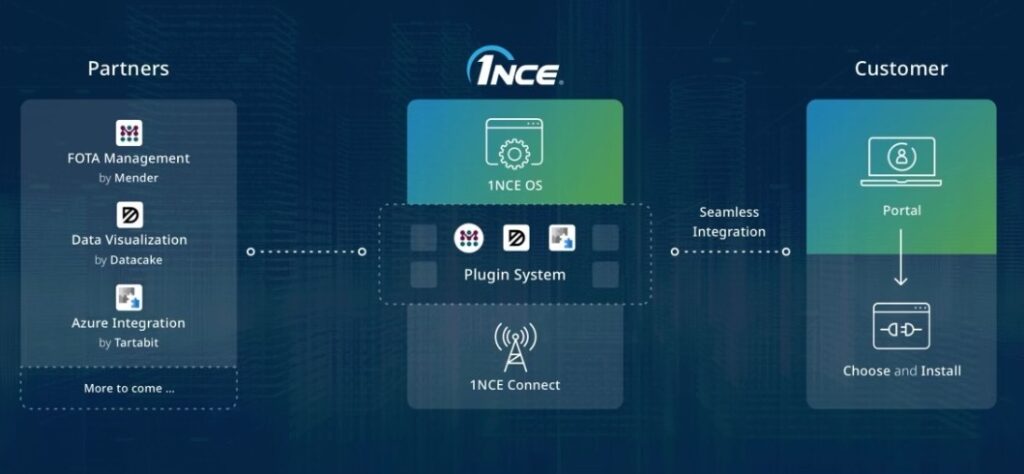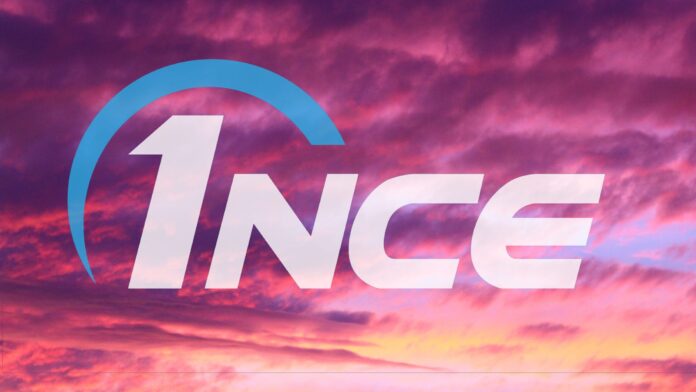Germany-headquartered IoT MVNO 1NCE has announced a series of software plugins in its cloud-based connectivity management platform to accelerate IoT development projects, and spearhead its development as an open software system for global IoT connectivity. It claims to have posted a 33 percent jump in connection volumes in 2023, adding five million cellular IoT connections in the period to finish the year with around 20 million devices under management.
The firm, with major backing from Deutsche Telekom and Softbank, added 1.2 million in December alone – which would have been an annual total, give or take, a couple of years back, it said. It is showing its new plugin partners at the Consumer Electronics Show (CES) in Las Vegas this week (January 9-12), integrated and tested to enable new firmware over-the-air (FOTA) management, data visualisation, and cloud integration within the 1NCE platform.
1NCE will assess takeup through 2023 with a view to bring “around 10” additional IoT providers into the fold during the course of the year, and an ambition to set itself eventually as a community-led open-source standard for global IoT. It will have an even more robust showing at Mobile World Congress (MWC) in Barcelona in six weeks (February 26-29), it said. The point, now, is to ram home that it is more than just an MVNO for connectivity, it suggested.
Ivo Rook, chief operating officer at 1NCE, explains the company’s rapid end-of-year additions: “Why does that December number matter? Because it shows we’re ready to scale. We are now doing more than a million endpoints per month without overheating our factory. Which is the part we perfected in 2023. Our services are being used in 165 countries, and ordered and delivered into 52 – with localised payment, systems, logistics, and so on.”
He adds: “So, we are truly global. On a quarterly basis, we’re probably the fastest growing company in IoT right now. Why? Because customers come for connectivity, and can’t believe the price – and then realise they’re getting all the software, as well. We always said we wanted to disrupt the connectivity market, and then the software market. And in 2023, we grew so fast that we proved that we have mastered the art of connectivity as a component.”

In a way, the new technical integration of software plugins – from Mender (for low-power FOTA management), Datacake (low-code visualisation dashboards), and Tartabit (alternative cloud integration, most significantly with Azure) – takes its proposed disruption of the software market to a new level by undercutting the standard cloud model, which requires IoT firms to subscribe to a whole package, and not just to cherry-pick the apps they want.
That’s the theory, anyway, even as 1NCE launches its new plugin offer with only three partners, and nothing yet in the way of choice in their various disciplines. But it has already opened-up positional data, for example, to developers to monetise as they see fit, and is providing free tools to further help with service authentication, protocol translation, device localisation, and energy optimisation, plus a ‘freedom-to-switch’ promise to move SIMs between carriers.
All of 1NCE’s software gadgetry is available with its definitive 10-for-10 flat-rate airtime fee ($/€10 for 10 years), which is a marketing hook, to an extent, that does not reflect the real flexibility of its billing portfolio, but is also commonly regarded by the industry as seminal tactic to make the IoT business case digestible to enterprises. Rook, once of Vodafone and T-Mobile, remarks: “We have disrupted the operator world – which we don’t think is so complex.
“We’ve turned connectivity into a component that can be built as a standard into connected products. Operators monetize complexity rather than selling simplicity. Whereas we have broken down the supply chain, rebuilt it, and made it very simple. And the next step is to do the same with software, which we have made strides with already in 2023. We have always said we are hungry, not greedy – that we want to offer everything, but not by ourselves.
“So we’ve opened our platform for external IoT providers to deliver clever software tools in the 1NCE platform. But we’re not just putting them out there; they are fully and deeply integrated. Which means customers can use them with a single click, and never have to re-authenticate – to deploy once, as per the name, and manage forever. Because we have an opinion about mobile operators, but we have an opinion about the SaaS industry, as well.
“Which is that operators know networks, but not global business. They are domestic enterprises, good for phones, but not for global IoT. All you want from them is access to the network; you want to avoid their IT systems. The challenge with the SaaS world is you’re presented with this model where you subscribe to an entire platform, only to use 10 percent of its functions. Which adds an enormous cost to every endpoint. So we are disrupting that model, as well.”

These bare-bones economics hinge on scale, of course – and bare-bones operations. 1NCE has 20,000 customers, now properly scattered about the world, reckons Rook. Ninety percent of its business is acquired, installed, and serviced online (“digitally”), he says. “Which makes it easy to communicate with them and analyse what they use.” 1NCE makes a gross margin of 70 percent on sales – billing for connectivity, with the whole SaaS offer in tow.
Rook says: “Out of the $10 [for 10 years of IoT connectivity, nominally], the cost of connectivity is only 15 percent. The real cost is in the software, which we have [so far] produced ourselves. And the more load we get on the platform, the less the cost per-connection. So, our unit-economics behave like a SaaS platform.” In ways, it is another telco-to-techco story, except 1NCE was only founded in 2017, and had to make it as a global telco first.
It now has the jump on the domestic operator crowd in its vault to low-cost cloud-based digital-change services, too – by integrating the same kind of economic disruption as part of its original 10-for-10 promise. It is notable – even remarkable – that 1NCE thinks connectivity is the gateway deal, but also just the table stakes. “Why connectivity? Because it is the easiest to monetize. Because people know they have to pay for connectivity,” says Rook.
“We are now growing with more than a million activations a month in the connectivity space, and so we’ve proven the 10-for-10 model is profitable and reliable. But it is just the marketing message; we have all these [airtime] levers – customers have devices for five months, five years; with 50MB [of data] per month, gigabytes per month. We have one price and hundreds of tariffs. It is what people understand, at the outset. But why on earth pay any more for it?”
Rook has an anecdote, which sounds plausible, about network tests in the US, where a first network was crowned as the fastest, a second as the most reliable, and a third as the “most awarded”. He says: “They’re all the same. There are no bad networks, it is freaking electricity – I mean, come on – especially for an IoT device. Once it works, the connectivity is irrelevant. Networks don’t matter. What matters is the data. Which is why we launched the platform.”
So far as connectivity goes, the argument says that a dollar per year is the nominal economic threshold where IoT is a no-brainer for the solution developer and the enterprise user, and a 70 percent margin is the threshold for a digital service provider to differentiate on software tools and cloud services. The sums add up, presumably, so long as global scale is achieved – and somehow, in the end, the platform becomes an open-source standard for a self-fulfilling ecosystem.
“We wanted to give customers control of their own data. And now we’re taking on the software world through plugins – because IoT developers should be deploying their capital in the solution, and not in the management of connectivity and the data… We want to be a standard for building connected products, which is why we’re obsessed that you integrate once, build once, deploy once – at low cost, without increasing prices or adjacencies.”
Rook finishes: “It needs to be a single-click experience, which works without commitment. Ultimately, we want to reach a point where customers communicate with each other. And we don’t even want customers, actually; we want followers. They already talk to each other about the platform – about protocols for ML ingestion, say. And if we hear it 100 times, we’ll launch it. But that still puts us in the middle, where we want, one day, for the platform to be in the hands of the whole ecosystem.”

